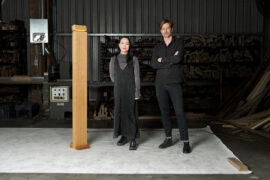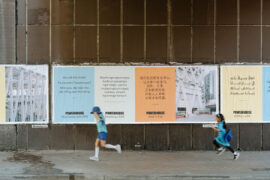In anticipation of modulyss’ latest arriving on Australian shores, we delve deep into the psychology of colour in design.
Despite interacting with it in every moment of our lives, our understanding of colour has surprisingly come in dribs and drabs throughout history. From Isaac Newton’s experiments with sunlight and prisms in the 1660s, to Josef Albers Interaction of Colour in 1963, to our understanding now, the topic of colour, particularly in architecture and design, can still be quite contentious.
As most basically a manifestation of the visible light spectrum, the actual perception of colour is a highly personal experience. Due to our own physiology, personal preferences, experiences, cultural differences and, of course, immediate context, there is little to no guarantee that anyone will take away the same (likely subconscious) meaning as anyone else, or even that the colour one person perceives will be exactly the same as from their neighbour’s perspective.
Regardless, that’s still no reason to put down your paintbrushes just yet. Within architecture and design, colour holds the same importance it always has. Used in the right situations, colour can assist in healing times, improve concentration, sell things, and even make you better at sport, as one study of athlete’s red uniforms showed.
Furthermore, as another study discusses, “objects in coloured scenes are more easily detected, more easily identified, more easily grouped, and more easily remembered than objects in black-and-white scenes.”
Despite the relativity of emotional response, colours can still be applied with some logical reasoning attached. Designing with blues may give a space a sense of calmness and concentration, while reds are significantly louder, more suitable in moderation or wherever spaces need to be imbued with a sense of energy and passion. Thanks to both genetic and learned meanings, picked up through common cultural or commercial exposure, colour psychology is capable of assigning many colours specific undertones.
This is true for every possible surface within architecture and design – without going overboard. Realising this, modulyss has recently launched their new collection, Millennium, a new generation of future-proof carpet. One of its key ranges, Millenium NxtGen is available in 36 different shades and capable of mixing and matching with multiple shades from the other ranges in the collection as well as compatible colours from alternative collections in the modulyss portfolio. With this almost endless array of colour nuances, projects can now achieve a truly unmatched degree of original and authentic design to suit an equally unmatched degree of different applications.
Having recently graced over 80,000 square metres of floor in the new NATO headquarters in Brussels, the Millenium range’s distinct low loop pile presents a uniquely durable attribute for high-traffic zones. Using more than six different colourways for this mammoth design scheme, the brainstrust behind the project were driven to achieve an inclusive, international environment that could speak to the cultural variations in colour communication.
Reflecting the unity and adaptability of the international facility, Millenium NxtGen’s specification in the new NATO headquarters responds to the corporation’s evolving needs on a global scale. Allowing for a configurable use of the building – of which modular carpet tile represents this versatility and flexibility on a micro scale (or, if you consider the mammoth 80,000sqm floorplate, macro scale!) – Millenum NxtGen’s unique durability, sustainability and aesthetic properties literally provide the ‘groundwork’ for NATO’s:


But what might this mean at a broader scale? After all, in the business of creating environments, don’t we want them to achieve a degree of inclusivity and salubriousness to benefit their many and varied end-users? The competitive landscape of contemporary design demands that the nature of our spaces are necessarily flexible: we revel in a freedom of texture, format, pattern and colour as the building blocks to truly authentic and original results.
As such, Millennium NxtGen’s 36 colour variants – each in a tufted 1/10th loop gauge, dual-tip sheared, loop pile texture – extends the already vast modulyss portfolio, while still seamlessly integrating with each of the brand’s separate lines. And yet, for the lucky architects and designers in Europe who’ve had the chance to work with this latest drop, the appearance and form of Millennium NxtGen is merely half of the picture.
Over the past decade or so, many of the world’s carpet manufacturers – of which modulyss maintains its position as a frontrunner – have demonstrated pointed environmental aptitude, funnelling enormous amounts of funds and energy into both improving the sustainable business models of their own corporations and the mission of a more sustainable future for this industry at large. According to modulyss supplier in the Australasian market, Gibbon Group, the company has “made great strides in reducing greenhouse gas emissions, water consumption and an overall reliance on fossil fuels; in some cases substituting renewable energy sources.”
“modulyss has increased the use of both post-industrial and post-consumer waste materials in carpet production and now sustainable manufacturing has become the norm.” –Gibbon Group.
After their watershed moment in 2007 when modulyss became the very first European manufacturer to launch an entirely sustainable carpet product on the international stage, today it is still pushing the envelope to design a sustainable future. And, within this space, Millennium NxtGen represents a new crowning point.
“Are carpet tiles a sustainable flooring option? Our answer is a resounding yes. Ever since modulyss’ inception, our people, processes and products have been screened for their environmental impact. This has allowed us to develop a sustainable workflow over the years, delivering goods that are ecologically viable.”– modulyss.
With Millenium NxtGen’s pile manufactured from 100 per cent ECONYL nylon yarn, spun from recycled fishing nets and waste materials, and with an overall 64 per cent total recycled post-consumer content, the collection additionally features their back2back technology: a proprietary modified bitumen backing created largely from recycled waste dredged up from the bottom of the ocean and exhumed from countless landfill depositions across the European content. While in keeping with the modulyss dicta of health-first (for end-users and our environment, alike), the range is 100 per cent PVC free, thus significantly reducing potential VOC emissions. Or, in their own words,
“we want to tell a sustainability story that is accessible and above all, credible. Sustainability is integral to our business. It’s a journey we as executives make together with every single modulyss employee and our stakeholders. […] Our customers have a choice and we are bound to be a smart choice. Each day, we work hard to reach that goal.” – modulyss, Sustainability Report 2016.
INDESIGN is on instagram
Follow @indesignlive
A searchable and comprehensive guide for specifying leading products and their suppliers
Keep up to date with the latest and greatest from our industry BFF's!

The undeniable thread connecting Herman Miller and Knoll’s design legacies across the decades now finds its profound physical embodiment at MillerKnoll’s new Design Yard Archives.

A longstanding partnership turns a historic city into a hub for emerging talent

London-based design duo Raw Edges have joined forces with Established & Sons and Tongue & Groove to introduce Wall to Wall – a hand-stained, “living collection” that transforms parquet flooring into a canvas of colour, pattern, and possibility.

A statement showroom in the middle of Melbourne’s CBD gave Sculptform the opportunity to truly showcase its handcrafted philosophy and design credibility.

Designed by Stewart Hollenstein, in association with Stewart Architecture, Green Square Library is a vital community space facilitating lifelong learning and helping people connect in an emerging community.
The internet never sleeps! Here's the stuff you might have missed

AHEC’s KEEP exhibition at Cult Sydney sees six Australian architects craft lasting furniture pieces, on view until 4th October.

Type designer Vincent Chan, who delivered a keynote speech with the Powerhouse as part of Sydney Design Week, tells us about the history and importance of this niche profession.